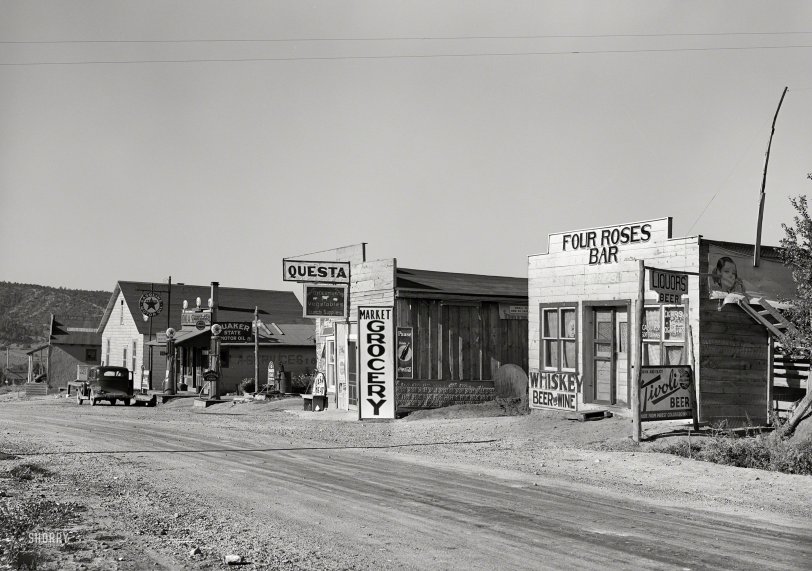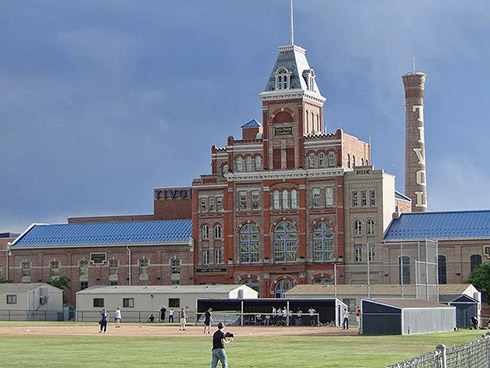


Framed or unframed, desk size to sofa size, printed by us in Arizona and Alabama since 2007. Explore now.
Shorpy is funded by you. Patreon contributors get an ad-free experience.
Learn more.

- Details, Details
- What's that building to the left of the tower?
- Coal Barges
- Bromo-Seltzer
- Inner harbor
- The Basin
- What a headache!
- Giant stepladder?
- Baldwin 62303
- Baldwin VO-1000
- Cold
- No expense spared
- Tough Guys
- Lost in Toyland
- And without gloves
- If I were a blindfolded time traveler
- Smoke Consumer Also Cooks
- Oh that stove!
- Possibly still there?
- What?!?
- $100 Reward
- Freeze Frame
- Texas Flyer wanted
- Just a Year Too Soon
- WWII -- Replacing men with women at the railroad crossing.
- Yes, Icing
- You kids drive me nuts!
- NOT An Easy Job
- I wonder
- Just add window boxes
Print Emporium
Questa: 1939

September 1939. "Street scene. Questa, New Mexico." One last look at the business district of this bucolic burg before we motor west. Medium format acetate negative by Russell Lee for the Farm Security Administration. View full size.
Sipping Four Roses at the Four Roses.
That step just outside the door of the Four Roses Cafe seems like it would be trouble for a sober man but a man full of Four Roses Bourbon served by the saucy redheaded Four Roses barmaid would defy gravity and blessed drunkenness if he were able to navigate it and steer a homeward bound course.
Lunch Supplies
The typeface on the Groceries sign looks very modern and a bit out of place compared to the others. Is it neon?

If These Shabby, Flimsy Walls Could Only Talk
They might say a few things about a rough little town. Excerpt from Another Time in This Place: Historia, Cultura y Vida en Questa (2003) by Tessie Rael y Ortega and Judith Cuddihy:
"“At this time [1943], Questa had the most despicable reputation with anyone else. So Father Smith decided to do something. One day he got an axe and starting tearing down the bridge, the only way out of town. When people saw what he was doing, they were furious. They said, “What are you doing that for?” And Father Smith said, “If I don’t tear down the bridge, it’ll fall down.” The people said, “In that case, we’ll help you.” So they tore it down and then they realized what they had done. “Now we can’t get out of town,” they said. Father Smith said, “I guess you’ll have to build another one.” And they did.
Father Smith lived in a house on top of a hill where the Parish Hall is now located. From there he could see everything that was going on in town—who was fighting, who was hanging out in bars, and so forth. One day he had a police siren mounted on top of his car. Whenever he saw a disturbance, he’d turn on the siren and go down. He said to them, “Did you see it? Did you hear it? Then swallow it.” He succeeded in remodeling Questa. Two years later it won a prize for civil cooperation.”
Tivoli Brewery
Founded in 1859, closed in 1969, and reopened in 2016 in its original Denver location.

Am I seeing right?
Does the sign by the hood of the car really read "MONEY FOR SALE"?
[No, honey. - Dave]
Indian(a) Gasoline, father of Texaco
Indian Refining Company was one of the ancestors of Texaco. I found this page with a history of Indian Asphalt/Indian Refining of Indiana (only sort of), Havermeyer Oil (the creators of Havoline motor oil), and Texaco in all its variations.
Given how Indian and Texaco's histories are intertwined, I'm not the least surprised to find an Indian pump installed at a station sporting a Texaco sign.
Indian Gas
The nearer pump globe sports an "Indian Gas" logo. Who has the dope on Indian brand gasoline? Bet those globes fetch a few bucks today.

























On Shorpy:
Today’s Top 5